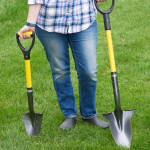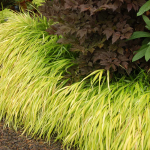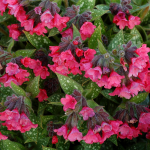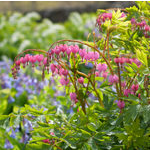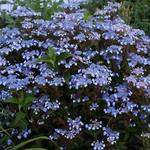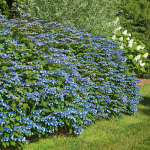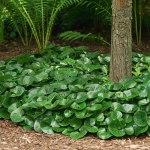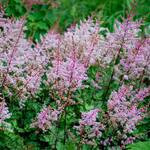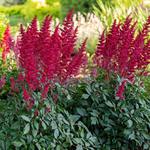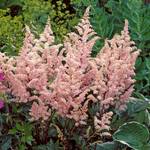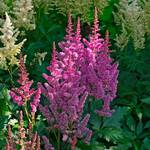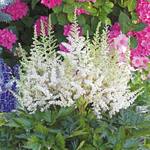Product Details
Are you new to gardening? Do you have a shady spot in your yard that could use a little color and life? Our Start a Garden for Full Shade collection contains 6 different perennials (plants that return year after year) that thrive in evenly moist soil and dappled light (defined as little to no direct sun per day). The plants were chosen by our horticultural experts to provide ease of care and a long season of interest. These plants tend to be forgiving, tough, and beautiful, all of which makes them ideal for beginners. 2 plants of the Brunnera and 1 each of the others for a total of 7 plants. Covers approximately 15 sq ft. Planting diagram included.
- 1 Pulmonaria 'Shrimps on the Barbie'
- 2 Brunnera macrophylla 'Jack Frost' (PP 13,859)
- 1 Phlox stolonifera 'Blue Ridge'
- 1 Geranium macrorrhizum 'Ingwersen's Variety' OR Geranium x cantabrigiense 'Biokovo' (our choice)
- 1 Ornamental Grass: Hakonechloa macra 'All Gold'
- 1 Christmas Fern: Polystichum acrostichoides
Before purchase, you’ll need to know your USDA Plant Hardiness Zone. This will determine whether or not the plants in this collection are hardy in your area and able to tolerate regional extremes of heat and cold. Click here to learn more about hardiness zones and to find yours. If your zone is between 5-8, this garden is for you.
What can you expect?
In springtime, Pulmonaria ‘Shrimps on the Barbie’ brings its distinctive polka-dotted foliage and splashes of bright pink blossoms to shady spots. Over time, it spreads gradually to form a lovely ground cover.
Phlox stolonifera ‘Blue Ridge’ is another early attraction. This Tufted Creeping Phlox attracts pollinators, including hummingbirds, with generously sized lilac-blue blossoms that stand out in the spring garden. The plant’s rounded, evergreen to semi-evergreen leaves form a ground cover for the balance of the season.
Also appearing in spring is mounding Brunnera macrophylla ‘Jack Frost.’ Its heart-shaped, silver leaves are veined and outlined in green, providing an extended season of interest. This favorite is sometimes called “False Forget-Me-Not” for the tiny azure flowers that appear in clusters in mid-spring, but the enduring attraction is the foliage, which emerges in early spring and keeps its good looks through late summer.
Japanese Forest Grass Hakonechloa macra ‘All Gold’ adds bold contrasting color and form over a full season. The chartreuse blades flow in one direction like water and they shimmer in a breeze, adding a wavelike sense of motion to the garden.
Perennial Geranium macrorrhizum ‘Ingwersen’s Variety’ produces neat, rounded mounds of matte green, highly aromatic foliage that look splendid from spring to fall. The leaves turn red and orange in autumn, adding a notable attraction to the late-season garden. Plants produce small pink flowers in spring, but it’s the foliage that counts. ‘Ingersen’s Variety’ spreads gradually (not aggressively) to form a handsome, weed-suppressing ground cover. Or you may receive Perennial Geranium x cantabrigiense 'Biokovo.' This attractive and carefree ground cover offers a long season of interest in gardens with part shade and full shade. These hardy plants produce a weed-smothering carpet of green, aromatic, semi-evergreen foliage that takes on red tones in autumn. Spring brings a flurry of delicate blush white blossoms with pink shading in their veins, bases, and stamens, but it’s the foliage that provides the longer show. Plants spread gradually by underground stems.
The sturdy, deep green fronds of Polystichum acrostichoides, perhaps better known as Christmas Fern, bring contrasting form and texture to the garden while offering year-round, evergreen color. The 2' fronds are often used in holiday decorations (but will disappear under snow in colder climates).
Plants in your Start a Garden collection will arrive in one of two forms: potted and/or bareroot. Bareroots may sound intimidating, but they’re not. In fact, they’re remarkably easy to plant. Visit the Growing Guide (see tab above) to learn more now or consult the Quick Start Guide you will receive when your new garden arrives.
Enjoy this garden of beautiful, shade-loving treasures for many years to come. We hope it’s the start of many great gardening adventures.
For more information on growing and care, click Growing Guide.
Shipping
HOW PLANTS ARE SHIPPED
The size of the plants we ship has been selected to reduce the shock of transplanting. For some, this means a large, bareroot crown. Others cannot travel bareroot or transplant best if grown in containers. We ship these perennials and annuals in 1 pint pots, except as noted. We must point out that many perennials will not bloom the first year after planting, but will the following year, amply rewarding your patience. We ship bulbs as dormant, bare bulbs, sometimes with some wood shavings or moss. Shrubs, Roses, vines, and other woody plants may be shipped bareroot or in pots. The size of the pot is noted in the quick facts for each item.
WHEN WE SHIP
We ship our bulbs and plants at the right time for planting in your area, except as noted, with orders dispatched on a first-come, first-served basis by climate zone. We also ship a wide range of containers and planters, tools, supplies, fertilizers, garden wear, garden decor items, as well as indoor decorations like wreaths and dried bouquets when available. Estimated dates for shipping are indicated in the green Shipping Details box for each item. Please supply a street address for delivery. Kindly contact us with two weeks notice, if you'll be away at the expected time of delivery.
OUR GUARANTEE
We guarantee to ship plants that are in prime condition for growing. If your order is damaged or fails to meet your expectations, we will cheerfully replace or refund it. Please contact our Customer Service Department at 1-800-503-9624 or email us at [email protected]. Please include your order number or customer number when contacting us.
Reviews
Average Customer Rating:
 (1 Review)
Write a Review
(1 Review)
Write a Review
Sort by:
Phlox stolonifera can’t bloom in shade 
A viewer from Washington, DC
It has been our experience that in most shade situations Phlox stolonifera 'Blue Ridge' is a delightful spring bloomer. It also makes a terrific semi-evergreen ground cover.
Growing guide
Welcome to the world of gardening & our Start a Garden series
Growing Your Start a Garden for Full Shade
Our Start a Garden for Full Shade collection contains 6 different perennials (plants that return year after year) that thrive in evenly moist soil and full shade (defined as bright reflected or dappled light but little to no direct sun per day). The plants were chosen by our horticultural experts to provide ease of care and a long season of interest. These plants tend to be forgiving, tough, and beautiful, all of which makes them ideal for beginners. Deer generally don’t find them appetizing.
As you begin your first garden adventure, keep in mind that freshly planted perennials need time to settle in and establish roots. In their first season, they will divert much of their energy to this endeavor. As a result, your plants may or may not produce flowers in their first year. Waiting for plants to settle in and grow is a process by which many gardeners begin to develop one of the most important traits a green thumb can possess: patience. Experienced gardeners know that in a first year, a perennial “sleeps.” In the second year, it “creeps.” And by the third year, it “leaps.” Watch over time as your perennials gain in size, forming broader clumps and increasing their foliage and flower shows. As a general rule, expect your plants to reach their mature size in three years.
This guide includes the following sections:
- Knowing & Growing Your Plants
- About Bareroot Plants
- Laying Out Your Garden
- Caring for Your Garden
- Companions
- Calendar of Care
The plants in the Start a Garden for Full Shade are ordered below roughly in order of their peak season of interest. The plants near the top of the list blossom ahead of those near the bottom:
- Phlox stolonifera (Common Name: Creeping Phlox)
One of the most distinctive sights in the spring garden is Creeping Phlox, a spreading, mat-forming, fuss-free perennial that smothers itself in colorful, five-petaled blossoms early in the season. The blossoms arrive right on cue to accompany late-flowering Daffodils and Tulips, and they provide an early feast for pollinators. Creeping Phlox thrive in part- to full-shade gardens and in moist, well-drained soil that is rich in organic matter. (Even moisture and full shade are required in the South.) Plants spread gradually by stolons (above-ground runners) to form dense, weed-smothering mats of evergreen to semi-evergreen foliage. When the blossoms subside, Creeping Phlox serves as an attractive year-round ground cover. If you wish to tidy up your Creeping Phlox, flower stems can be cut back after the blossoms fade.
- Pulmonaria (Common Name: Lungwort)
Spotted or speckled foliage and colorful blooms set Pulmonarias apart in the spring garden where they flower in the company of spring-flowering bulbs while attracting and feeding hummingbirds and bees. These favorites for low-light areas add interest over a long season with the foliage remaining evergreen in milder climates. Pulmonaria is happiest in partial or full shade and average to damp soil. As the plants emerge in early spring, it’s notable that their flower buds have already formed before they push up out of the earth. Pulmonaria may disappear in a summer drought, then reemerge when the weather cools and rain returns. In the South, plants may not do well in summer but generally reappear and bloom the following spring. Despite the plants' bristly leaves, slugs find Lungworts appetizing. If they invade, set out shallow bowls of beer, use child- and pet-safe iron-phosphate pellets, or handpick and remove them to keep the population in check. This will keep the foliage looking its best.
- Brunnera macrophylla (Common Name: Siberian Bugloss; Heartleaf Bugloss)
One of the great charmers of the shade garden, Brunnera arrives early, adding a long season of interest with its heart-shaped silvery leaves that on some varieties are patterned with green veining or highlights. In late spring, slender stems rise well above the foliage and are topped with tiny blue flowers that resemble Forget-Me-Nots. The foliage forms a tidy clump that suppresses weeds. These plants perform best in partial to full shade and well-drained soil that is moderately fertile and humus-rich. Dried and unsightly leaves can be removed, but at season’s end, it’s best to allow spent foliage to remain on the plant to protect the crowns. After the ground freezes, apply a light layer of mulch. Brunnera is free of serious pests and diseases. The deer- and rabbit-resistant plants will spread slowly by rhizomes (underground runners), gradually creating a lovely ground cover.
- Geranium (Common Name: Cranesbill)
When most people hear the word “Geraniums,” they think of pots filled with the colorful, lollipop-like flower heads of annual Geraniums (botanically known as Pelargoniums). But the garden universe is fortunate enough to also include an array of Perennial Geraniums (Cranesbills). These rugged, indispensable, problem-solving plants are highly cherished by gardeners for their adaptability, long season of interest, and fuss-free dispositions. Perennial Geraniums form attractive mounds of deeply dissected leaves that are festooned with five-petaled, single blossoms. On some Cranesbills, the foliage changes to reddish orange in autumn, and it can remain evergreen in climates where plants aren’t covered in snow.
Perennial Geraniums prefer part shade (with a few varieties tolerant of full shade), and average, well-drained soil. If over time they seem to not be doing well, a balanced, granular fertilizer can be applied in early spring. These plants rarely need to be divided. Some varieties will spread and sprawl around other plants. This won’t harm the other plants, but if you don’t like the look, simply give the Geranium a haircut to create a tidier mound. Perennial Geraniums are largely immune to pests and diseases. Position your Geranium along the edge of your garden bed, and don’t be surprised if you find yourself adding more.
- Polystichum acrostichoides (Common Name: Christmas Fern)
All Ferns thrive in light to heavy shade with soil that is well-drained and rich in organic matter. Water Ferns regularly if rain is not sufficient, and do not let the soil get completely dry. A 2″ thick mulch of composted leaves or Pine needles will help keep roots cool and damp. When Fern fronds appear to be smaller or the clump has a bare center, it is time to divide. Some Ferns form crowns while others grow as mats of fibrous roots. Dig up the whole clump and take 6″-square pieces from the most vigorous growth. Replant at the original depth and water well. Christmas Ferns (Polystichum acrostichoides) have several especially appealing characteristics. The new upright fronds unfurl from the center of the clump in spring and gradually relax into a rounded mound. Plants are evergreen, and they provide welcome color in the winter landscape (unless covered by snow). Older foliage can remain on the plant, but it may also be cut out, if desired, to make a tidier appearance. Other than an occasional slug attack, these beautiful, fuss-free plants are largely immune to serious pests and diseases. In cold climates, you may wish to apply a 1–2” layer of mulch around all types of Ferns to serve as a winter coat and prevent any frost heaving.
- Hakonechloa macra (Common Name: Japanese Forest Grass)
Vivid color, arching form, and the habit of billowing in the breeze have made Japanese Forest Grass a favorite of gardeners and garden designers. Plants produce slender blades in colors of chartreuse (Hakonechloa ‘All Gold’) or variegated green-and-yellow (Hakonechloa ‘Aureola’), adding welcome contrast amid other shade and part-shade dwellers including Pulmonarias, Brunneras, Ferns, Hellebores, and Hostas. The blades of Hakonechloa tend to grow in a single direction, creating a cascading habit that suggests a small waterfall. When the wind blows, the blades sway in a wavelike motion that adds movement to the garden. Plants prefer consistently moist, well-drained soil that is rich in organic matter. They bloom in summer, sending up straw-like wisps, but it is the foliage that is the attraction here. Over time, Hakonechloas spread by rhizomes (underground runners) to form sizeable clumps. They are easily divided, if desired or if they are encroaching on other plants, or you may leave them as is to grow wider and wider. Before the new growth appears in early spring, cut back the spent blades (perhaps strewing around a few for nest-building birds). Despite their graceful habits, Hakonechloas are rugged, fuss-free plants. They shrug off pests and diseases while providing a long season of color and interest in any full- or part-shade garden.
Plants in your Start a Garden collection will arrive in one of two forms: potted and/or bareroot. Bareroots may sound intimidating, but they’re not. In fact, they’re remarkably easy to plant.
Bareroots are exactly what the term would imply: a healthy division of a mature plant to include a portion of its roots (minus most or all green growth and soil) and a portion of the crown (the point where a plant’s roots meet its stems). Depending on the type of plant, these roots may present themselves in a broad array of shapes and sizes – from the knobby looking chunks of a Liatris to the wisps of an Astilbe (which often trail a mass of delicate roots). Bareroots don’t look like much on arrival, but they are the beginnings of beautiful plants. Most bareroots are shipped packaged in damp sawdust or shredded paper. Plant them as soon as possible upon receipt or keep them in a cool, dark place (such as a basement or a closet) for up to 2 weeks.
To plant bareroots:
- Remove and discard the packaging material
- Save the plant tags, which provide helpful information and may also serve to mark a planting site
- Soak bareroots in water for 1 hour to rehydrate them then plant at the depth recommended on the plant tag
- Water thoroughly
- Depending on when bareroots are planted, they will take some time to settle in and develop root systems
If your bareroot is planted in spring, it will gradually begin pushing up top growth and you’ll see the emergence of leaves and stems as the plant begins to grow above ground. If your bareroot is planted in fall, it will develop a good root system and may send up a few leaves before going dormant for winter. Top growth will emerge in spring as the days grow longer and sun warms the soil.
If you experience a bit of trepidation with your first bareroots, the ease of planting them and their vigor once settled will win you over in no time. In the span of a single season, they become established plants that are poised to perform like champs in your garden.
To lay out your garden to best advantage, first see the Planting Plan that is included in your box. Keep in mind that you don’t have to position your Start a Garden for Full Shade plants exactly as we show them in the plan. Our diagram is just one possible design based on the heights, shapes, and compatibility of the plants. Your garden bed may have different dimensions, you might wish to tuck your plants into several areas, or you could use them to flank a path so you can stroll through the garden.
With the exception of the Phlox, the perennials in your collection all mature to approximately the same height, and they don’t vary much in how much they spread. For those reasons, they can be laid out in different ways. The Creeping Phlox is, as its name would suggest, a low-growing ground cover so keep in mind it will be best at the edge of the garden or, if you happen to have a rock or rock wall, it would be happy to grow around and even over one.
The mature height and recommended spacing for each perennial can be found on the tags that accompany each plant. (It’s best to keep these tags and put them in the ground alongside your perennials. That way, you’ll remember which is which, and, in periods of dormancy when perennials die back to the ground, you’ll know where you planted them.) Keep in mind that garden design is flexible and plants are forgiving. As your perennials settle in and grow, you may or may not like the arrangement. If you are not pleased, take advantage of mild conditions in spring or fall to gently dig up your plants and relocate them to create a more agreeable design.
Light: The plants in this collection will grow and flower best in full shade, which is defined as bright reflected or dappled light but very little to zero hours of direct sun per day. These plants thrive in the filtered light that sneaks through an overhead canopy of leaves and in the shadow of other taller plants or structures that shield them from the sun.
Watering: Start a Garden for Full Shade plants perform best in evenly moist but well-drained soil that is rich in organic matter.
Immediately after you plant your new perennials, water them well to settle the soil around them. In the weeks and months that follow, hydration is key to helping them become successfully established. Pay attention to how wet or dry the soil is – you don’t want to let the plants dry out entirely, but they will suffer if they are in constantly wet soil (the roots may rot). The best way to assess the moisture level in your soil is to stick your finger in it to a depth of 1”. If the soil feels moist, do not water. Wait until it feels somewhat dry. The general rule is that new plants need approximately 1” of water per week whether it’s supplied by Mother Nature or your garden hose or watering can. Once your plants are established, they will need watering only during periods of prolonged drought (i.e., no rain for several weeks). If possible, avoid overhead irrigation. It is best practice to water plants at the soil level, which means wetting the ground around and between them but not spraying directly on or at them. Water sprayed on leaves can promote fungus and disease. Another important rule of successful hydration is to water plants deeply and infrequently. Why? Watering daily or too frequently in small amounts encourages plants to produce shallow roots, which may not be sufficient to sustain them during dry spells. Watering deeply and infrequently encourages root growth well below the surface of the soil, which is where plants are likely to find moisture in times when rain is scarce.
Fertilizer, Soil & pH: There is no need for fertilizing at the time of planting since doing so may negatively impact a plant’s proper development. Instead, we hope you and all new gardeners will develop what is widely regarded as best practice when it comes to using fertilizer: In lieu of feeding individual plants (which is often encouraged by some companies that sell chemical fertilizers and additives), think in terms of feeding the soil which, in turn, will nourish your plants naturally. It’s easy: After your perennials have had a year to settle in, apply 1–2” of organic matter, such as compost or well-rotted manure, around the base of the plants in early spring. This will take care of their nutritional needs, and no additional fertilizer will be necessary. All of the plants in the Start a Garden for Full Shade are adaptable to most soil types but prefer a moist, well-drained loam and a neutral pH from 6.0 to 7.0. Testing your garden soil’s pH is not a requirement (some of us here at the farm have never done it in our home gardens while others swear by it). To learn more about soil testing and how to go about it, click here.
Pests/Diseases: The plants in this garden are generally free from diseases and insect pests. But like any plants, they are most susceptible to disease when faced with stressful conditions. Eliminate the stress for your plants by providing them with what they need: adequate shade, proper watering, and good drainage.
Deadheading: Deadheading is the process of removing spent blossoms to encourage the formation of additional flowers or, in the case of non-reflowering plants such as those featured in our Start a Garden for Full Shade collection, to tidy plants and improve their appearance when and if necessary. [See plant descriptions above for specifics about deadheading the individual plants in this collection.]
Dividing/Transplanting: Allow your plants to fill out for a few years. It’s OK to let them touch and grow together. But if plants begin to appear crowded, which can impede good air circulation and force them to compete for resources, you may choose to divide some including the Phlox divericata, Christmas Fern, and Hakonechloa. Division is best done in early spring or fall when temperatures are most likely to be mild. (The higher heat of summer can stress plants, making division and transplantation a bit more perilous. In the South, division is best done in fall so plants can recover before hot weather returns.) To divide your plants, use a shovel to dig up a section or the entire root ball. Using the blade of the shovel, chop the root ball into sections or, if the divisions separate easily, use your hands to tease them apart. Geranium macrorrhizum can also be divided, but because it grows at the surface of the soil, the pieces can be jiggled out by hand and replanted. There is no need for a shovel. Transplant all of your divisions to new areas of the garden, use them to fill in any gaps, or share with friends and family.
The following plants thrive in the same growing conditions as the perennials in your Start a Garden for Full Shade. They would all make fine additions to your garden.Companions:
- Astilbe (Astilbe)
- Ligularias (Ligularia)
- Bleeding Hearts (Dicentra spectabilis)
- Hostas
- Hellebores
Early Spring: Cut back remaining stems and stalks from last season when it no longer looks good, before new growth appears in spring, such as with the Hakonechloa. Clear away any dead or winter-burned foliage. Look for early emerging foliage of the Pulmonaria and Brunnera. Weed the garden and, every year or couple of years, depending on the vitality of your plants and the condition of your soil, you may wish to apply a 1” layer of compost after the plants have emerged. The compost will enrich the soil, which provides food for the plants. For best results, apply the compost around the base of the plants, not on top of them.
Late Spring: Once the ground warms, a light, 1–2” layer of mulch will help conserve moisture in the soil and insulate roots. Choose a good quality commercial mulch or use leaves, Pine needles, Pine bark mulch, or shredded bark. Make sure to spread the mulch around the plants, not on top of them. If there has been little rain for several weeks (or longer), water your plants. They need to be well hydrated as they begin their springtime growth spurt.
Summer: Be sure plants are getting enough water, supplementing if it hasn't rained. Weed to remove unwanted plants that can crowd or take nutrients away from your plants.
Fall & End-of-Season Care: The Phlox and Christmas Fern are both semi- to evergreen. Leave them be so they can bring color and texture to your winter garden while providing habitat for wildlife. The foliage of the Brunnera and Pulmonaria will subside and turn brown. Leave fallen leaves where they are to serve as insulation for the plants’ crowns, but do not let them pile up so thick that they smother them). The foliage of the Geranium may change color in fall, adding interest to the garden. Cut back only when and if the leaves begin to subside or let them decay naturally, providing habitat for small garden visitors. Spreading a light 2–3” layer of mulch over gardens in colder regions is as beneficial as a winter coat.
To learn more, see our Expert Resources for New Gardeners.
To download a PDF of our New Gardeners Handbook, click here.
To download a PDF of our Glossary of gardening words, click here.

